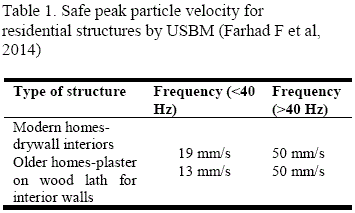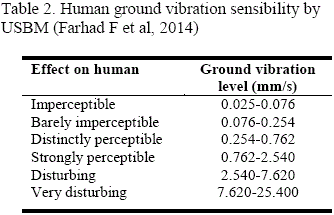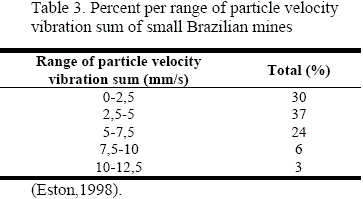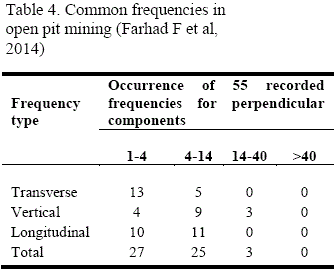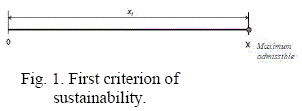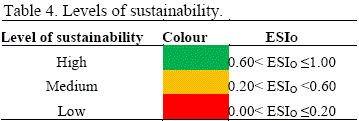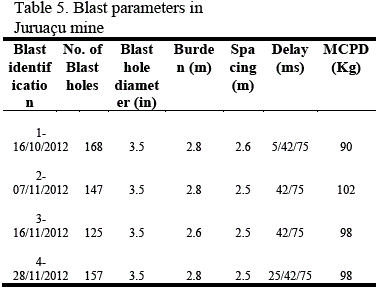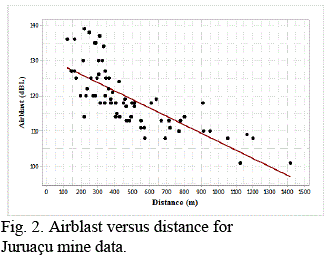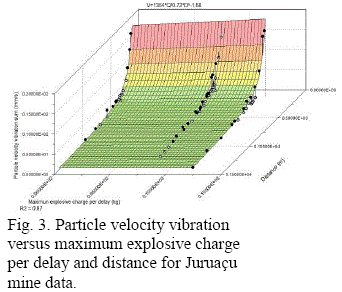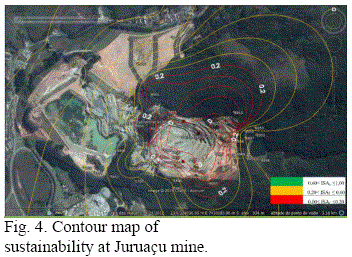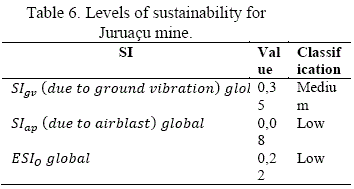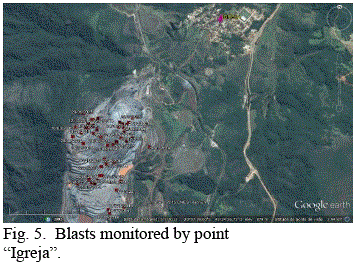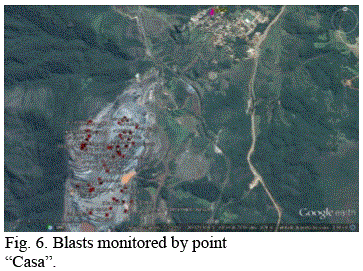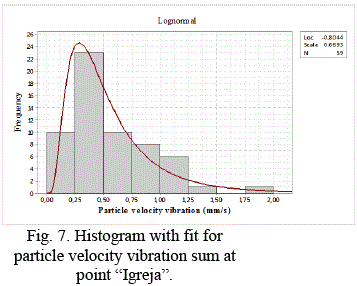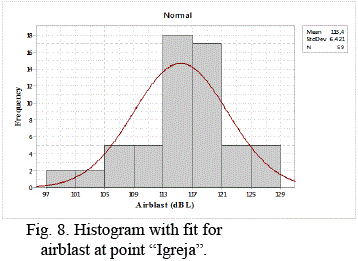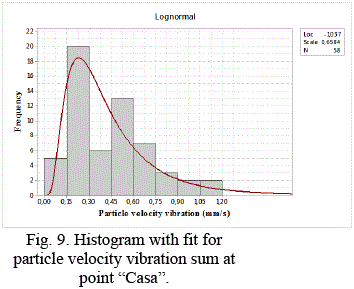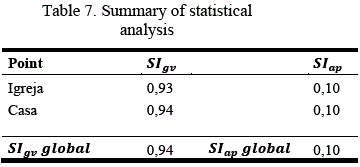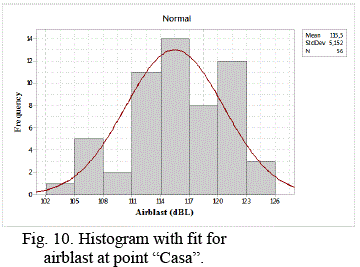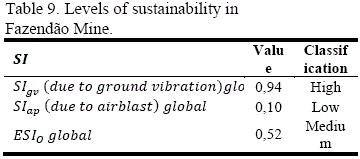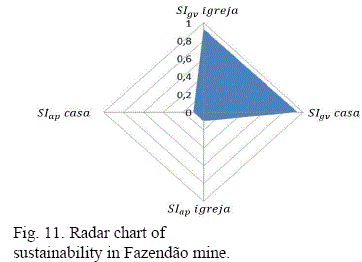Servicios Personalizados
Revista
Articulo
Indicadores
Links relacionados
Compartir
Revista de Medio Ambiente y Mineria
versión impresa ISSN 2519-5352
REV. MAMYM vol.4 no.1 Oruro jun. 2019
ARTÍCULOS
Assessment of blasts environmental sustainability in open pit mining -
Case study in small and large Brazilian mines
Evaluación de la sostenibilidad ambiental de explotaciones en minería
a cielo abierto - Estudio de caso en minas brasileñas grandes y pequeñas
Vidal Félix Navarro Torresa Sergio Médici de Estonb Wilson Siguemasa Iraminac Leandro Geraldo Canaan Silveirad João Henrique Rodrigues Costae
a Vale Institute of Technology, Belo Horizonte, Minas Gerais, Brazil, vidal.torres@itv.org
b São Paulo University, smeston@usp.br
c São Paulo University, wilson.iramina@poli.usp.br
d Vale Institute of Technology, Belo Horizonte, Minas Gerais, Brazil, leandro.silveira@itv.org
e Vale Institute of Technology, Belo Horizonte, Minas Gerais, Brazil, joao.costa@pq.itv.org
Recibido: 13-02-2019 Aceptado: 08-03-2019
Abstract
Assessment of blasts environmental sustainability in open pit mining deals with the development and application of an innovative mathematical model for environmental sustainability evaluation based on characteristics and quality standards of several parameters of the main four environmental components (atmosphere, lithosphere, hydrosphere and biosphere). Due to the great complexity of environmental parameters in open pit mining, the developed mathematical model was validated for only ground vibration and airblast in small and large Brazilian open pit mines. In both cases, the research focuses are human discomfort and structural damage.
Keywords. Environmental Sustainability, blasts, mathematical model, open pit mining.
Resumen
La evaluación de la sostenibilidad ambiental de explotaciones en la minería a cielo abierto se ocupa del desarrollo y la aplicación de un modelo matemático innovador para la evaluación de la sostenibilidad ambiental basada en las características y estándares de calidad de varios parámetros de los cuatro componentes ambientales principales (atmósfera, litosfera, hidrosfera y biosfera). Debido a la gran complejidad de los parámetros ambientales en la minería a cielo abierto, el modelo matemático desarrollado fue validado solo para la vibración del suelo y el chorro de aire en minas a cielo abierto brasileñas grandes y pequeñas. En ambos casos, los focos de investigación son la incomodidad humana y el daño estructural.
Palabras clave. sostenibilidad ambiental, explosiones, modelo matemático, minería a cielo abierto.
1. Introduction
Sustainable development is defined as the one that meets the needs of current generations without comprising the ability of future ages to achieve their own necessities (WCED, 1987). Furthermore, sustainability can be comprehended as every piece of action in order to follow the sustainable development and it is known fact that this concept must include at least three pillars, environmental, social and economic (Navarro Torres, V. F.; Gama, C. D., 2005). Whenthe issue comes to mining activities, especially in open pit mining, the attention is focused on environmental impact related to the ore exploitation and increasing concern with sustainability in this sector has been noticed.
The exploitation of ore resources in open pit mines as well as in quarries frequently involves rock blasting operations. Nevertheless, according to Dinis da Gama (1998), only 5 to 15% of the energy released by blasts is used effectively to fragment rock. It means that the largest part is transferred to the surrounding environment in form of side effects, likely to cause significant structural damage and human discomfort, which consist the most common cause of concerns and protests by affected people in the neighbourhood of these works.
A thoroughly literature review has shown some scientific work has been performed aiming quantify sustainabi lity, highlighting those ones from Yale Center for Environmental Law and Policy and the Center for International Earth Science Information Network, Columbia University between 1999 and 2005, which has monitored 21 sustainability indices, including present and past levels of pollution, for instance (ESI, 2005). However, there are not any papers related to quantification of environmental sustainability in open pit mining.
Recent researches on this topic correspond to those applied in underground mines (Dinis da Gama C., Navarro Torres V.F. et al, 2012, Navarro Torres. V.F. et al., 2009). Hence, a mathematical model to quantify sustainability in open pit mining is extremely significant.
2. Characterization of environmental impact in open pit mining
Open pit mining operations handle large volumes of ore and waste. As a result, during this process, there are risks of environmental impact on: atmosphere, underground and surficial water, rock mass and soil, biodiversity as well as the human being. Rock excavation modifies natural slopes, consequently altering its natural state of tensions. In its turn, use of explosives may cause ground vibration and air blast in the surrounding areas to blasts. Recent studies carried out in a city nearby an open pit mine, in Brazil, has shown that gases pollutants and respirable suspended particles generated by diesel oil emissions affects the respiratory system of people (Braga et al., 2007). Another environmental impact is the leaching that occurs when the water gets in touch with exploitation fronts or even with waste dumps and hence lead pollutants to rivers, lakes and aquifers.
Particle velocity vibration and frequency are the most used parameters in order to assess the side effects of rock blasts. According to Kahndelwal, M; Shing T.N (2006), frequency plays a key role in vibration analysis, because the response of the buildings nearby the seismic wave's propagation zones depends on ground vibration frequency.
Particularly, ground vibration might cause damage in buildings, whereby the safe peak rticle velocity for residential structures according to USBM is function of frequency (Table 1).
Human vibration sensibility depends on peak particle velocity level, vibration frequency, event duration and frequency of event. For values approximately below 2 Hz, the body acts as a unit mass. For sitting position, the first resonance is occurs between 4 and 6 Hz. On the other hand, for the standing one, resonance peaks occurs about 6 and 12 Hz. The USBM has suggested a human vibration sensibility basis of particle velocity (Table 2).
Eston (1998) carried out 133 measurements of primary and secondary blasts during 6 years, using engineering seismographs, in small Brazilian mines aiming at a behaviour analysis of ranges of particle velocity vibration and the frequencies as illustrated in Table 3 and Fig.2. Note that the majority of the vibration records are inferior to 5 mm/s and the frequency is less than 50 Hz.
In most cases of rock blasts in medium and large-scale open pit mining, the occurrence of frequencies are observed as shown in Table 4.
3. Mathematical modelling of sustainability in open pit mines
The environmental sustainability in open pit mining is based on main environmental components and it can be expressed by the Environmental sustainability index (ESI0), as follows:
Where: N is the number of possible environmental components, SIa is the atmosphere sustainability index, SIg is the geotechnical sustainability index, SIw is the water sustainability index (surface and underground), SIb is the biological sustainability index, related to animals and plants and SIN is any other possible component.
All the sustainability indices of open pit mining will be calculated by a single equation, as follows:
Where: n is the number of pollutants, l1, l2,....,ln are the numbers of evaluation/measurement locations, α1, α2,....αn are the environmental parameters on evaluation and P1, P2,.....Pn are the admissibility standards.
A careful analysis of the environmental parameters in open pit mining has allowed a characterization of three groups, regarding their environmental effects and admissibility standards.
Based on these three groups of environmental parameters, considering Y as a minimum acceptable standard, X as a maximum permissible standard and xi as the local condition of environmental parameters on assessment, it was developed mathematical expressions to calculate the sustainability index (SI) according to three criteria, taking into account a scale of 0 to one 1.
a) When xi < X;
b) When xi > Y and;
c) When Y < xi < X
The specifics cases of ground vibration and airblast correspond to first criterion (Fig. 3), which means xi < X and their general equation is as follows:
Conditions:
a) If xi=X or xi>X, so SI1=0;
b) If xi=0, so SI1=1
Moreover, it can be adopted levels of sustainability as presented in Table 4.
4. Case studies - model validation for ground vibration and airblast.
4.1. Small mine
4.1.1. Description of the area
The Juruaçu open pit mine is located in Perus, state of São Paulo, Brazil, 30 km distance from the homonym capital. Its mining activity consists of sand and rock exploitation and then further processing to civil construction. It is carried out detonations of explosives charges to fragment granitic rock, which is transported by conveyor belts to successive stages of grinding, until reach the specified size. The annual average production rounds 1.8 Mt and the waste withdrawal is 180.000 m3.
The mine is located in crystalline terrains of the São Roque Group, in the geomorphological province of Atlantic plateau, subdivision ridge of São Roque Zone (IPT, 1981). This group is mainly compounded of clastic sediments, predominantly clayey nature, metamorphosed into phyllites. Besides, it can be observed outcrops of conglomeratic metasediments, amphibolites, limestone and abundantly intrusive granites (Coutinho, 1972). The Atlantic plateau mainly consists of crystalline rocks, Precambrian and Cambro-Ordovician, cut by covers of sedimentary basins of São Paulo and Taubaté and by intrusive basic rocks and alkaline Mesozoic-Tertiary (IPT, 1981). The ridge of São Roque comprises an extensive mountainous area of diverse lithology ranging from low-grade metamorphic to migmatic and gneissic rocks with granitic intrusions.
Moreover, rounded top hills with restricted ridges and slopes with straight profiles, sometimes abrupt, characterize the relief of Juruaçu area. Drainage is high density with restricted interior alluvial plains, closed valleys with dendritic pattern (IPT, 1981).
4.1.2. Monitoring of ground vibration and airblast.
It was carried out the monitoring of 4 blasts in distinct days and it was installed 20 engineering seismographs at several points surrounding to the detonation of explosive charges area in order to record particle velocity vibration (mm/s) and airblast (dBL). The equipment was from GEOSONICS®, fifteen SSU 3000EZ + model with the following serial numbers: SN 8894, SN8895, SN 8896, SN8897, SN 8947, SN8849, SN 8950, SN 8951, SN 8952, SN 8953, SN 8954, 8955 SN, SN 8956, SN 8957 and five SSU 3000LC model with serial numbers SN3700, SN 3702, SN3706, SN 3707, SN 3708. Furthermore, they were set for a trigger of 0.18 to 0.5 mm / s and temporal window of 5 s. The main blast parameters can be seen in Table 5.
4.1.3. Recorded database and propagation law of vibration
All 71-recorded data of airblast in the measurement points were plotted in function of its distance from the respective source and presented in Fig. 5. It is noticeable that the major airblast values occurs on short distances and lessen when the space between the measure and the blast becomes larger, for a R squared of 0.57.
Several authors (Dinis da Gama, 1998; Holmberg, 2000) recognized that the most utilized equation in science in order to describe the behaviour of seismic waves in the ground, generated by blast is the following:
Where: v is the particle velocity vibration sum (mm/s), Q is the maximun explosive charge per delay (Kg), D is the distance between the blast and measurement points and a, b, c are the constants of locations and particularities of the blast.
From this equation it can be obtained a chart of iso-velocities of vibration (an accurate map of vibration generated by kriging interpolation between known points), once that recorded data of vibration would be available to attain this relation and thus recalculate the vibration velocity. In this way, as depicted in Fig. 6, it was used the statistic software LABFit® to plot all data of particle vibration velocity recorded, together with maximum explosive charge per delay and the distance.
The statistical data processing has allowed obtaining the propagation law of vibration, for a correlation of 0.87, as expressed:
The constants value is quite similar to those descripted by various authors and organized by Navarro Torres VF & Bernardo P (2004), thus ensuring more trust on this parameters and hence constituting a powerful tool to recalculate the vibration velocity and then calculate the sustainability indices.
4.1.4. Environmental sustainability index
There are not any Brazilian official standards of human comfort whereby it was applied the standard CETESB D7.013 (2015) from the state of São Paulo, Brazil, (mine location), maximum limit of 4.2 m/s. Using (2), the particular equation to calculate the geotechnical sustainability index in any point due to ground vibration is:
Where: v is the particle vibration velocity sum (mm/s).
By its turn, it was also applied (2) to calculate the atmospheric sustainability index due to airblast, regarding CETESB D7.013, maximum value of 128 dBL, as follows:
Where: p is the airblast (dBL).
From any point and its respective SIgv and SIap, it can be generated a contour map of environmental sustainability, using the software Surfer®, as depicted in Fig. 7. Note that, in areas closer to the community, the mine operates with an Environmental sustainability index of round 0.5, which we considerate a medium level of sustainability. The worst values, less or equal to 0.2, occurs inside and around the pit, which is explicated by the highest levels of vibration and airblast due to the short distance between measurement points and source.
Moreover, this mine sustainability can be evaluated as a whole by the calculus of Environmental sustainability index (ESI0) using (1) and (2), as presented in Table 6.
4.2. Large scale mine
4.2.1. Description
Fazendão is an open pit mine located in Mariana, state of Minas Gerais, Brazil, 140 km of distance from its capital, Belo Horizonte. It is property of VALE.S.A., withinthe "Quadrilátero Ferrífero", an area of intense iron mining activity, which consists its work. The Quadrilátero Ferrífero is considered as one of the most important mineral provinces in the world, comprising important deposits of iron, as well as gold and manganese. The large iron ore reserves are found in metamorphic Precambrian rocks of Paleoproterozoic Cauê Formation, offering great economic interest due to its grade and extent.
4.2.2. Monitoring of ground vibration an airblast
As the main objective of this study was to validate the model, it was used the data base relative to the monitoring carried out by Sequência Engenharia Projetos e Meio Ambiente Ltda (2014; 2015). In order to record ground vibration and airblast it was used 6 Instantel Inc. seismographs model: MiniMate DS-077 Série II, MiniMate Plus, MiniMate Pro4 e MicroMate, with the following serial numbers: 4499, 5935, BE 17764, BE17765, MP 12698 and UM 6308. They were located in two points, called "Igreja" and "Casa" in the community surrounding to the mine so as to register the parameters related to its respective monitored blasts, as depicted in Fig. 9 and 10. Furthermore, they were set for a trigger of 0.51 mm/s and temporal window of 5 s. Blast parameters or even blast design were not informed.
4.2.3. Recorded data base and statistical data treatment.
It was not possible to obtain the propagation law of vibration due to the great number of measurements in only two points, therefore it has become necessary a statistical data treatment, using in this case the software Minitab®, in order to obtain the most representative value of particle velocity vibration and airblast for the evaluation locals to apply in the model. Fig. 11 presents the histogram with fit, regarding the identified distribution, for particle velocity vibration at the point "Igreja".
Fig. 12 represents the histogram with fit, regarding the identified distribution, for airblast at the point "Igreja". We have noticed that Weibull distributions have shown bigger p -value than the Normal distribution, however we have assumed the second one, supported by the Central limit theorem, which states that the majority of random phenomena could be approximate to normal distributions, when the randomness of a physical phenomenon is the accumulation of small additive random effects (SOONG, 2004).
Once again, Fig. 13 and 14 represents the histogram with fit for particle vibration velocity and airblast, but this time for the point "Casa". The interpretation was based on Central limit theorem. Table 7 summarizes the statistical analysis, showing the expectancy for the mean value for all data set.
4.2.4. Environmental sustainability index
1. Aiming calculate the geotechnical sustainability index due to ground vibration, (SIgv) it was applied the standard CETESB D7.013 from the state of São Paulo, Brazil, maximum limit of 4.2 m/s for human comfort. Additionally, if we evaluate the structural damage, applying the American standard, USBM (RI 8507), for instance, which establish the maximum limit of 13 mm/s for dominating frequencies below 40 Hz in old buildings the particular equation from (2) results a SIgv, as follows:
Where: v is the particle vibration velocity sum (mm/s)
In its turn, it was also applied (2) to calculate the atmospheric sustainability index due to airblast, regarding CETESB D7.013, maximum value of 128 dBL, as follows:
Where: p is the airblast (dBL).
Table 8 and 9 presents the results from (5) and (4) for the measurement points and the global value of Environmental sustainability index from (1) with its classification, respectively.
In order to provide a better view of how does the Sustainability indices vary, it was built a radar chart as depicted in Fig. 15.
5. Conclusions
The developed mathematical model quantifies environmental sustainability in open pit mining through the Environmental sustainability Index expressed in the scale 0 to 1, where values close to zero reflect the proximity to the permissible value. On the other hand, indices near to one can be interpreted as an absence of pollutant.
The model validation for two parameters (ground vibration and airblast), in small and large scale mines, shows its great potential in the assessment and management of environmental sustainability in open pit mines.
To ensure a properly assessment of sustainability in Fazendão Mine, it would be necessary a major number of measurements points. Nevertheless, once that our aim was to validate the model, the database was sufficient.
2. Acknowledgments
Authors would like to thank Vale Institute of Technology for support this research project. Thanks, are also due to the Vale- Fazendão Mine for providing the necessary data. In addition, authors would also like to express their deep-felt gratitude to USP - Universidade de São Paulo for the partnership and availability during the scientific work.
3. References
1. 2005 Environmental Sustainabilty Index (ESI) (2005). New Haven, Conn.: Yale Center for Environmental Law & Policy. 2005. [ Links ]
2. Braga, A. L. F; Pereira, L. A. P; Procópio, M.; André, P.A Saldiva, P. H. Associação entre poluição atmosférica e doenças respiratórias e cardiovasculares na cidade de Itabira, Minas Gerais, Brasil. Rio de Janeiro: Cad. Saúde Pública, Sup 4:S570-S578,2007. 9 p. [ Links ]
3. Dinis da Gama, C. "Ruídos e Vibrações Ligados à Utilização dos Explosivos e Equipamentos". Comunicações do 1º Seminario de Auditorias Ambientais Internas. Divisão de Minas e Pedreiras do Instituto Geológico e Mineiro de Portugal. 1998. [ Links ]
4. Dinis da Gama C, Navarro Torres VF and Verissimo AC. Scienfific Final Report WP 6: Environmental Assessment of UCG and CO2 Storage, European Project, 2012, 23p. [ Links ]
5. Coutinho, J.M.V. Petrologia do pré-cambriano de São Paulo e arredores. Boletim IG- USO, v.3. São Paulo. 1972, p 5-99. [ Links ]
6. Farhad F, Mohammad Ali EF and Hamid M. Simultaneous investigation of blast induced ground vibration and airblast effects on safety level of structures and human in surface blasting. International Journal of Mining Science and Technology 24 (2014) 663-669 p. [ Links ]
7. Holmberg, R. - Explosives and Blasting Technique. Proc. 1st World Conference on Explosives & Blasting Techniques. A. Balkema, Rotterdam. 2000 [ Links ]
8. Eston, S. M. Uma análise dos níveis de vibração associados a detonações. São Paulo: Escola Politécnica da Universidade de São Paulo. Doctoral thesis. 1998. p 101-103. [ Links ]
9. Instituto de Pesquisas Tecnológicas do Estado de São Paulo - IPT. Mapa Geomorfológico do Estado de São Paulo. Escala 1: 1000.000. São Paulo. 2 V. Publication IPTNº 1.183, 1981. [ Links ]
10. Kahndelwal, M.; Shing TN. Prediction of blast induced ground vibrations and frequency in opencast mine: a neural network approach. JSound Vib. 2006. 289 p. [ Links ]
11. Navarro Torres V.F; Bernardo P. El "Blastware III" e "Mlinreg.bas" como herramientas para la prevención y control ambiental de vibraciones en voladuras. V Simposium Internacional de Tecnología de la Información Aplicada a la Minería 14 - 17 de setembro, Lima-Perú. 2004. 20 p. [ Links ]
12. Navarro Torres, V. F.; Dinis Da Gama, C. Engenharia ambiental subterrânea e aplicações. Rio de Janeiro: CETEM/CYTED, 2005. 550 p. [ Links ]
13. Navarro Torres, V.F.; Dinis Da Gama, C. Environmental sustainability index of geotechnical works. Geotechnical National Congress. Lisboa, 2009, 10pp. [ Links ]
14. Soong, T.T. Fundamentals of Probability and Statistics for Engineers. State University of New York at Buffalo, Buffalo., New York. USA. 2004,p 199. [ Links ]
15. Sequência Engenharia Projetos E Meio Ambiente Ltda. Relatório de monitoramento sismográfico. Mina de Fazendão. 2014. 232 p. [ Links ]
16. Sequência Engenharia Projetos E Meio Ambiente Ltda. Relatório de monitoramento sismográfico. Mina de Fazendão. 2015. 208 p [ Links ]
17. WCED (World Commission on Environment and Development). Our Common Future. Oxford: Oxford University Press, 1987. 300 p. [ Links ]













